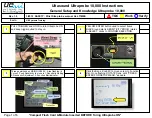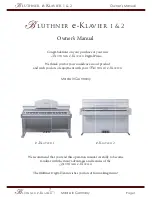
OTHER CONNECTIONS
PAGE
|
30
Gas Purge connector
A gas purge is highly recommended when operating the laser in dirty or dusty environments. Purging the
laser creates a positive pressure inside the laser housing that prevents dirt and debris from accumulating
on optical surfaces including beam combiner, telescope, and turning optics. In condensing atmospheres,
a gas purge helps to reduce the potential for condensation damage.
To connect the f201 gas purge port, perform the steps described below:
1
Connect nitrogen or breathing-grade air to the Gas Purge connector using 1/4-inch plastic tubing.
2
Push the tubing completely into the fitting and then pull the tubing lightly to ensure that it is locked
into place.
Important Note: Note: To disconnect gas purge tubing, first push and hold the tubing slightly into
the fitting. Next push the white fitting ring evenly towards the fitting, and then pull the tubing free.
3
Set a purge pressure between 13.8–34.5 kPa (2–5 PSI). This provides just enough positive airflow
to prevent dust from entering the laser. If a flowmeter is available, set a flow rate of 0.85–1.7 m
3
/hr
(30–60 SCFH, Standard Cubic Feet per Hour) at a pressure not to exceed 34.5 kPa (5 PSI).
The Gas Purge connector on your f201 laser must be connected to a source of nitrogen or clean, dry air
only; do not use any other gases for purging. Purge gas specifications are listed in the table below.
Gas Purge connector
Table 2-6 Purge gas specifications.
Pure Gas
Specification
Nitrogen
High Purity Grade > 99.9500% purity; filtered to ISO Class 1 particulate level
Air
Breathing Grade > 99.9996% purity; filtered to ISO Class 1 particulate level
Air
Compressed - Instrument-grade air filtered and dried to ISO 8573-1:2010 Class 1, 2, 1 (< 10 1.0–
5.0 μm
particles/m3; < –40 °F dew point; < 0.01 mg/m3 oil vapor)
Caution: Possible Equipment Damage
Turn off DC power before installing or removing any plug or cable from the User I/O connector.
Ensure that user connections are made to the appropriate pins and that the appropriate signal levels
are applied. Failure to do so may damage the laser.
Caution: Possible Equipment Damage
Do not exceed a gas purge pressure of 34.5 kPa (5 PSI). Excessive pressure may damage the purge
assembly or other internal laser components.
Do not use argon as a purge gas. Use only nitrogen or clean, dry air as described in Table 1-6, Purge
gas specifications.
Содержание f201
Страница 1: ...ENGINEERED BY SYNRAD f201 Laser User Manual...
Страница 15: ...INVENTORY PAGE 15 Inventory F201 Lasers Figure 2 3 f201 shipping box contents...
Страница 36: ...F201 LABEL LOCATIONS PAGE 36 f201 label locations Figure 3 1 100 hazard label locations...
Страница 37: ...F201 LABEL LOCATIONS CONTINUED PAGE 37 f201 label locations continued Figure 3 2 F 200 hazard label locations...
Страница 38: ...F201 LABEL LOCATIONS CONTINUED PAGE 38 f201 label locations continued Figure 3 3 F 201 hazard label locations...
Страница 44: ...COMPLIANCE PAGE 44 Figure 3 4 f201 Declaration Document...
Страница 45: ...COMPLIANCE PAGE 45 Figure 3 5 continued F201 Declaration Document...
Страница 76: ...INTEGRATING F201 SAFETY FEATURES PAGE 76 Figure 4 15 F201 packaging diagram...
Страница 77: ...F201 GENERAL SPECIFICATIONS PAGE 77 f201 general specifications Table 4 8 f201 general specifications...
Страница 78: ...F201 GENERAL SPECIFICATIONS PAGE 78 Table 4 9 f201 general specifications continued...
Страница 89: ...STATUS LEDS PAGE 89 Table 5 6 Over Temperature fault Table 5 7 Shutter closed condition Table 5 8 VSWR fault...
Страница 104: ...INDEX PAGE 1 This page is intentionally left blank...















































